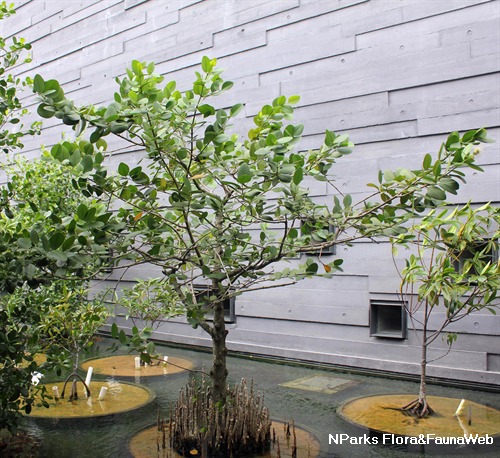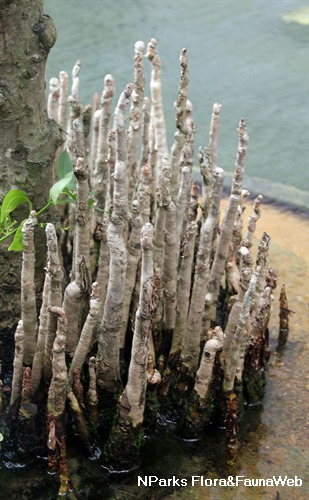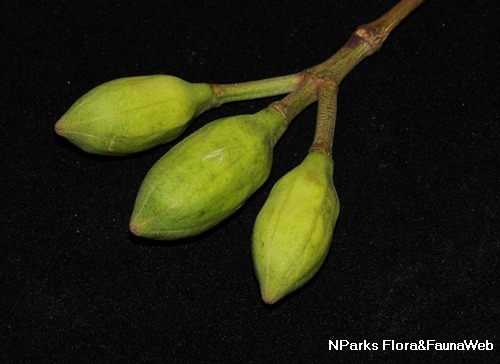
Name
Classifications and Characteristics
| Plant Division | Angiosperms (Flowering Seed Plants) (Dicotyledon) |
|---|---|
| Plant Growth Form | Tree (Medium (16m-30m)) |
| Lifespan (in Singapore) | Perennial |
| Mode of Nutrition | Autotrophic |
| Plant Shape | Irregular |
| Maximum Height | 20 m |
Biogeography
| Native Distribution | China, Vietnam, Thailand, Malaysia, Singapore, Riau Archipelago, Java, South Sulawesi, the Moluccas, and South-east New Guinea |
|---|---|
| Native Habitat | Shoreline (Mangrove Forest) |
| Preferred Climate Zone | Tropical |
| Local Conservation Status | Native to Singapore (Critically Endangered (CR)) |
Description and Ethnobotany
| Growth Form | It is a tree up to 20 m tall, with up to 0.2 m tall upright, breathing roots (pneumatophores) at its base. |
|---|---|
| Roots | The upright breathing roots (pneumatophores) are up to 0.2 m tall. |
| Foliage | Its opposite, shortly-stalked leaves have leaf blades that are shiny dark green, usually broadly egg-shaped to nearly circular, and 4–10 by 3–9 cm. |
| Flowers | Its apetalous flowers are found singly or up to 3 together, with the interiors of its sepals tinged red. Its flowers open at dusk, giving off a smell of sour milk, and last for one night. |
| Fruit | Its green fruits are somewhat pear-shaped berries, 3–4.8 cm wide, and contain many seeds. Its buoyant, water-dispersed seeds are tiny, white, flattened, and embedded in the fruit’s fleshy pulp. |
| Habitat | It grows in the brackish-water area, and muddy soil at the landward edge of mangrove forests. It occurs locally in Kranji, Pulau Ubin, Pasir Ris, Pulau Tekong, Sungei Mandai Kechil, and Sungei Pandan. |
| Associated Fauna | Its flowers are visited by fruit bats and honeybirds. It is the preferred local food plant for caterpillars of the moths Eucosma, Taurometopa pyrometalla and Zeuzera conferta. |
| Cultivation | It is propagated by seed. |
| Etymology | Latin Sonneratia, commemorating Pierre Sonnerat (1749–1841), French botanist and explorer; Latin ovata, egg-shaped, referring to the shape of the leaf blades |
| Ethnobotanical Uses | Edible Plant Parts : Edible Fruits Food (Fruit or Vegetable): The edible fruits are used as substitutes for vinegar. Medicinal: The fruit is used as poultices to treat sprains, while their fermented juice is used to test for haemorrhages. Timber & Products: The timber, though of limited value, is used as firewood. Others: The bark contains tannin of minimal quantities to be used commercially. It is planted in coastal areas to control erosion of tidal river banks. |
Landscaping Features
| Landscaping | This tree is suitable for sites that are poorly drained, or exposed to seawater. It has an attractive dark green, compact crown, and large fruit. It may be grown at the edges of ponds or reservoirs. |
|---|---|
| Desirable Plant Features | Ornamental Flowers, Ornamental Fruits |
| Landscape Uses | Parks & Gardens, Coastal, Beachfront / Shoreline, Riverine, Pond / Lake / River, Marsh / Bog |
| Thematic Landscaping | Naturalistic Garden, Water Garden, Marsh Garden |
Fauna, Pollination and Dispersal
| Fauna Pollination Dispersal Associated Fauna | Bird-Attracting, Bat Food, Caterpillar Moth Food Plant |
|---|---|
| Pollination Method(s) | Biotic (Fauna) |
| Seed or Spore Dispersal | Abiotic |
Plant Care and Propagation
| Light Preference | Full Sun |
|---|---|
| Water Preference | Lots of Water |
| Plant Growth Rate | Moderate |
| Rootzone Tolerance | Waterlogged Soils (Does not Drain Site) |
| Maintenance Requirements | Moderate |
| Propagation Method | Seed |
Foliar
| Foliage Retention | Evergreen |
|---|---|
| Mature Foliage Colour(s) | Green |
| Foliar Type | Simple / Unifoliate |
| Foliar Arrangement Along Stem | Opposite |
| Foliar Attachment to Stem | Petiolate |
| Foliar Shape(s) | Non-Palm Foliage (Ovate) |
| Foliar Venation | Pinnate / Net |
| Foliar Margin | Entire |
Floral (Angiosperm)
| Flower & Plant Sexuality | Bisexual Flowers |
| Flower Colour(s) | White |
|---|---|
| Flower Grouping | Solitary |
| Flower Location | Terminal |
Fruit, Seed and Spore
| Mature Fruit Colour(s) | Green |
|---|---|
| Mature Fruit Texture(s) | Leathery |
| Fruit Classification | Simple Fruit |
| Fruit Type |
Image Repository
Others
| Master ID | 30431 |
|---|---|
| Species ID | 4740 |
| Flora Disclaimer | The information in this website has been compiled from reliable sources, such as reference works on medicinal plants. It is not a substitute for medical advice or treatment and NParks does not purport to provide any medical advice. Readers should always consult his/her physician before using or consuming a plant for medicinal purposes. |

.jpg)
-(8).jpg)
.jpg)
-(1).jpg)
.jpg)
.jpg)
-(32).jpg)










-(27).jpg)
